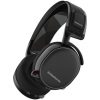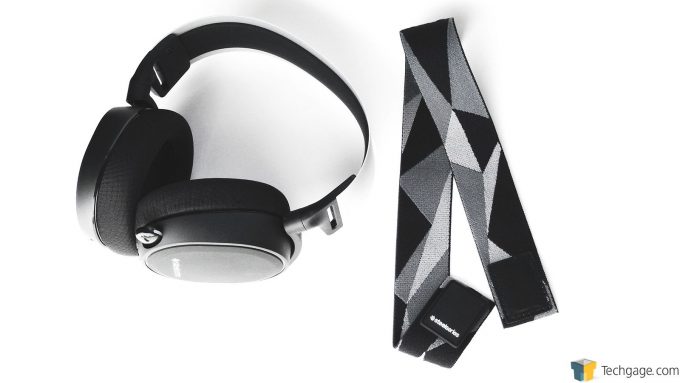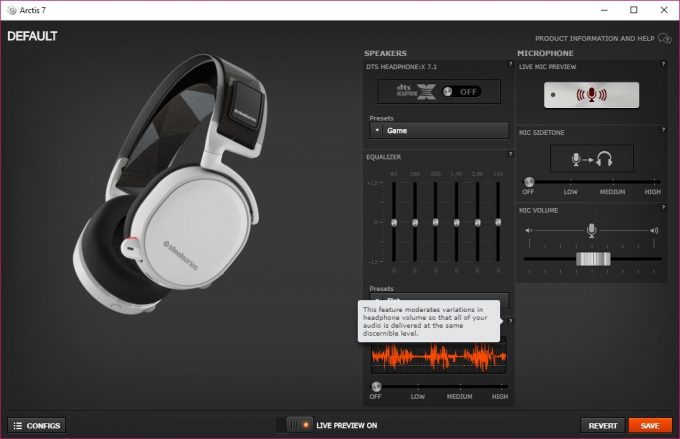- Qualcomm Launches Snapdragon 4 Gen 2 Mobile Platform
- AMD Launches Ryzen PRO 7000 Series Mobile & Desktop Platform
- Intel Launches Sleek Single-Slot Arc Pro A60 Workstation Graphics Card
- NVIDIA Announces Latest Ada Lovelace Additions: GeForce RTX 4060 Ti & RTX 4060
- Maxon Redshift With AMD Radeon GPU Rendering Support Now Available
SteelSeries Arctis 7 Wireless 7.1 Surround Sound Headset Review

Last month we looked at SteelSeries’ fantastic Arctis 5 surround sound headset, but now we’re looking at the top-tier headset in that product family, the Arctis 7. Knowing how well its little brother performed along with how much we liked the last wireless SteelSeries headset that we tested, means the Arctis 7 has some big shoes to fill.
Page 2 – SteelSeries Arctis 7 Testing
As mentioned in our Arctis 5 review, testing a headset is almost as subjective as it is objective, unless there’s a glaringly obvious shortcoming. To provide a form of standardized audio testing we went back to audiocheck.net and ran the Arctis 7 through the same tests as last time to compare this headset to its little brother, as well as a past top-end headset from SteelSeries, the H-Wireless.
We also performed another comparison test of the Clearcast microphone, gauged the comfort level of the headset, and looked at ease of use with regards to the placement of the on-ear controls and software. We also tested the battery life and the charge time with the battery completely exhausted.
Finally some general testing was performed by checking out the stereo and surround sound capabilities of the Arctis 7 in two drastically different game types, as well as while watching a movie and listening to music.
It should be said that just because we found this headset to perform a certain way doesn’t mean that others will if they were to run through the same tests. The results are affected by an individual’s hearing just as much as they are by the hardware chosen by the manufacturer.
I have hearing tests performed every 2 years that have been coming back clear, and always protect my ears if I’m playing with a band or attending a loud event. Based on this we feel confident that the vast majority of those with healthy hearing should have a similar experience.
Like before, in an effort to keep this review as short as possible, we won’t go into detail about each test and what it represents, but readers are more than free to head over to the website for more information. All tests were run with the EQ flat, and without any other options enabled unless specifically mentioned.
| Arctis 7 | Arctis 5 | H-Wireless | |
| Bass Response | 10Hz | 20Hz | 20Hz |
| Treble Response | 14KHz | 14KHz | 16KHz |
| Spectral Flatness | Flat | Slight dip in the upper range | Slight dip in the upper range |
| Dynamic Range | 72dB below full scale | 66dB below full scale | 66dB below full scale |
| Quality | No rattle or buzz | No rattle or buzz | No rattle or buzz |
| Driver Matching | OK | OK | Slight fluctuation towards right cup at mid-high frequencies |
| Wiring | OK | OK | OK |
| Binural Test | OK | OK | OK |
Looking at the table above we see that the bass response on the Arctis 7 is superior to the Arctis 5 and H-Wireless models. The sound produced by this test became audible at the lowest level provided, which bodes well for those who wants some truly deep bottom end.
During the spectral flatness test we found that all sounds were produced perfectly without any loud peaks or quiet dips meaning that either the drivers just happen to be matched to my hearing, or that my hearing is perfect and the Arctis 7 provides absolutely flat sound production.
While I’d love to think that my hearing is indeed perfect, it’s most likely a fluke that the drivers and my ears are closely matched. Whatever the reason, this should play into our gaming, movie, and music testing quite nicely.
The other improvement over the Arctis 5 came during the Dynamic Range test. We were able to hear sounds beyond the other two test models, meaning there’s a higher level of sound isolation. If the Arctis 7 was to be used in a noisy environment, such on the go with a mobile device, the dynamic range test results show that it would block out more outside noise than the Arctis 5 or the H-Wireless. Don’t confuse this result with total isolation as noises in the next room were muffled, but still audible.
The Clearcast microphone continues to impress, although it loses some clarity and sparkle when compared to the Arctis 5. The quality is still well above the H-Wireless’ muffled recording, but there’s a noticeable difference between the two Arctis headsets. Is this due to the wireless signal? We can’t say for certain, but in our eyes, or rather ears, the Arctis 7 falls behind slightly in this round of testing.
When it comes to comfort, things started off great, but after about 10 minutes we found that the aggressive bend in the metal headband created a fair bit of clamping force on my rather large noggin. This caused quite a bit of discomfort as part of my ear made contact with the thin foam lining the covers the speaker driver due to the shallow depth of the cups, and frequent adjustments were required to alleviate the pain.
Not everybody will experience this since smaller heads mean that the cups won’t be pulled as far apart and smaller ears will fit inside the cups better than mine did. For those with larger heads and ears, one possible way to combat this is to loosen up the flexible headband a bit more than normal, and/or to very gently try to take some of the bend out of the metal headband. We don’t suggest the latter as it could damage the headset, but if you’re feeling adventurous, who are we to stop you?
When it comes to ease of use, the Arctis 7 can’t get any simpler. Headband adjustments are easily made by resizing the contact patch on the headband wrap, and all of the on-ear controls are easy to find.
If the power button were raised a bit it would be easier to find, but after a while, hitting it became second nature. The volume and Chat-Mix dials move a little too freely and can be accidentally hit, but again, once the placement is learned it became a non-issue.
The SteelSeries Engine 3 software is also as simple as it gets. The options might appear basic, but it’s all there, and laid out very clearly. There’s also a ? in each corner that gives more information on what the options do, making any learning curve minimal.
Moving on to the battery life, the advertised 19 hours must be based on the headset pumping out sound at the maximum volume for the entire duration.
With the volume set to just shy of the half way point, which was the most comfortable listening level for me, we were able to get over 23 hours of sound out of the Arctis 7. Once the headset did finally power off after the battery ran out, it was ready to go again a short 4 hours later.
Support our efforts! With ad revenue at an all-time low for written websites, we're relying more than ever on reader support to help us continue putting so much effort into this type of content. You can support us by becoming a Patron, or by using our Amazon shopping affiliate links listed through our articles. Thanks for your support!






